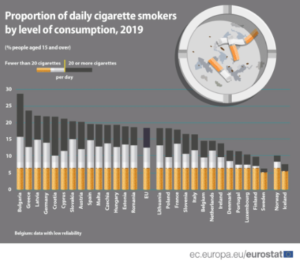Smoking is a major public health issue and the Covid crisis has only reinforced it. The WHO is urging countries to invest in helping more people quit smoking. However, the situation of older smokers is far from uniform across Europe.
In 2019, Germans aged 55-64 are among the heaviest smokers in Europe with 28% smoking daily. Belgians or French are only 19% at the same age. Even older, Germans also have a higher level of consumption than the other two countries, with 17% of smokers in the 65-74 age group, compared with 9% in the other two countries. And over the age of 75, 5% of Germans continue to smoke daily, while only 3% of French and Belgians do so.
What characterises German seniors in particular is that more of them smoke than the younger generations: 22% of 15-29 year olds smoke compared to 28% of 55-64 year olds. The same trend can be observed in Belgium, where 13% of 15-29 year olds smoke compared to 19% of 55-64 year olds. In contrast, in France and the UK, the proportion of young and old smokers is equivalent, with respectively 20% of 15-29 year olds and 19% of 55-64 year olds smoking on a daily basis in France and 16% of 16-24 year olds and 50-59 year olds in the UK.
It is therefore not surprising that according to the Seniosphere Council’s 2022 Well Aging Observatory, Germans have strongly changed their opinion on the need to stop smoking to age well since 2019. Indeed, in 2019, they were only 32% to consider that quitting smoking was very important, they are now twice as much or 60% to be convinced of it. The Covid crisis has completely changed their point of view, whereas already in 2019, around 60% of French and British people were convinced of this importance.

Apart from the higher percentage of senior smokers, what also distinguishes German smokers from Belgian and French smokers is the share of those who smoke more than 20 cigarettes per day, as shown in the graph above. More German seniors are daily smokers than in France and Belgium, with a higher proportion smoking more than 20 cigarettes per day.
What about gender differences in senior smokers?
The overall trend is for women to smoke less than men in Europe, but here again there are large differences between countries. The highest difference between male and female smokers is again found in Germany with 6 points less for women between 55 and 64 years old, whereas in France, Belgium and the United Kingdom the differences are more tenuous with a maximum difference of 3 points.
What is reassuring for the WHO is that the Baby Boom generation has reduced its cigarette consumption as it ages; indeed in the UK:
In 2000, 29% of those aged 60 and over, who were then 35-49, smoked
In 2010 at 50-59 they were 19% smoking
In 2020, only 9.1% of those aged 60 and over were smokers.
In 20 years, 20% of British baby-boomers have stopped smoking. Given that younger generations tend to smoke less, smoking should represent less of a public health issue in the future.
Source: Eurostat EHIS study 2019, Health Data UK 2020, Observatoire du Bien Vieillir 2022 Seniosphere Conseil



